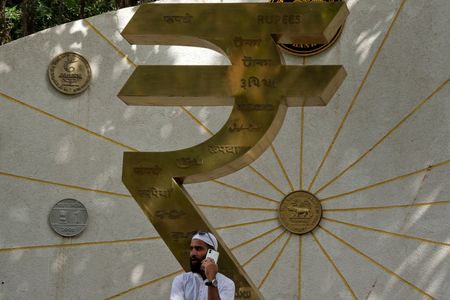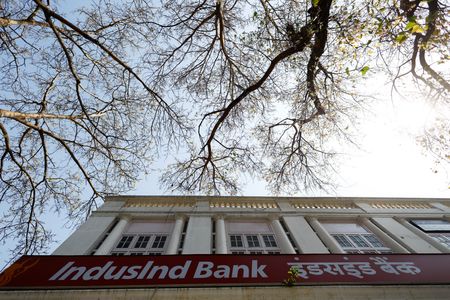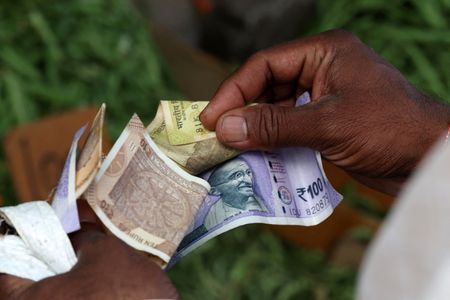By Dharamraj Dhutia and Nimesh Vora
MUMBAI (Reuters) -The Indian rupee’s trajectory this week will be dominated by developments on U.S. trade policy, with steep tariffs on Indian goods slated to take effect from Wednesday, while government bonds will track any developments on the fiscal front.
Relations between Washington and New Delhi have deteriorated, with U.S. officials openly criticizing India’s continued purchases of discounted Russian oil.
Washington has already imposed 25% duties on India, higher than on several other major trading partners, and Trump has said an extra 25% levy will take effect on August 27 in response to India’s continued purchases of Russian oil.
At the beginning of the week, the rupee will find support from the drop in the dollar index after Federal Reserve Chair Jerome Powell signaled a rate cut in September in his comments at Jackson Hole.
Powell indicated the July jobs report points to growing vulnerabilities in employment while diminishing worries about inflationary pressure.
It was a “dovish” Jackson Hole, Morgan Stanley said in a note.
“The Fed is prepared to cut rates as soon as September, barring a surprise in the August employment and CPI reports.”
The rupee ended little changed last week at 87.53 per dollar.
While early support for the rupee could come from Powell’s remarks, the focus for traders will quickly shift to U.S. tariff developments, said Kunal Kurani, vice president at Mecklai Financial.
Meanwhile, India’s 10-year benchmark 6.33% 2035 bond yield settled at 6.5510% on Friday, up 15 basis points over the week, its biggest such move in more than three years.
Traders anticipate the yield will remain in the 6.50% to 6.59% band this week, with focus on developments in New Delhi’s fiscal picture as well as the first quarter growth data that is due towards the end of the week.
Bond market sentiment weakened on fears of fiscal slippage after Prime Minister Narendra Modi unveiled sweeping goods and services tax reforms on August 15.
India plans to slash the levy by October and has proposed a move to a two-rate structure of 5% and 18%, scrapping the 12% and 28% rates in place currently, a top official had said.
The government has not quantified the loss to the exchequer from these changes. A panel of ministers on Thursday endorsed the new rate structure.
Still, Suyash Choudhary, head of fixed income at Bandhan Mutual Fund, said the government has had a responsible fiscal stance over an extended period of time, including the pandemic shock.
“Thus, we don’t expect a sudden change to aggressive expansion that will either jeopardize the debt/GDP framework or levy a very high burden of supply to the bond market.” KEY EVENTS:
India** June industrial output – August 28, Wednesday (4:00 p.m. IST)
** July fiscal deficit – August 29, Thursday (3:30 p.m. IST) ** April-June GDP growth data – August 29, Thursday (4:00 p.m. IST)(Reuters poll – 6.6%)
U.S. ** July new home sales units – August 25, Monday (7:30 p.m. IST) ** July durable goods – August 26, Tuesday (6:00 p.m. IST)
** August consumer confidence – August 26, Tuesday (7:30 p.m. IST)
** April-June second estimate of GDP – August 28, Thursday (6:00 p.m. IST)
** Initial weekly jobless claims for week to August 18 – August 28, Thursday (6:00 p.m. IST)
** July personal consumption expenditure index, core PCE index – August 29, Friday (6:00 p.m. IST)
** August U Mich sentiment final – August 29, Friday (7:30 p.m. IST)
(Reporting by Dharamraj Dhutia and Nimesh Vora; Editing by Janane Venkatraman)











